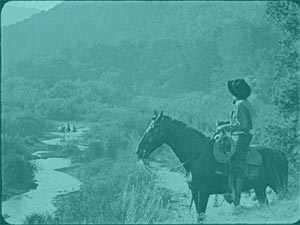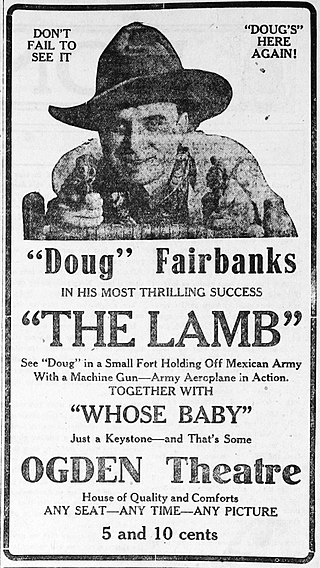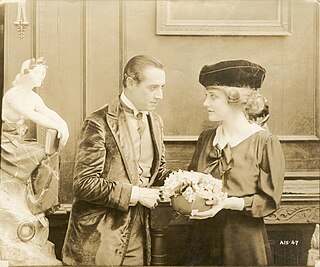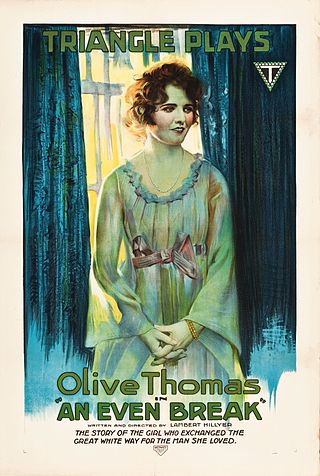
Rebecca of Sunnybrook Farm is a 1917 American silent comedy-drama film directed by Marshall Neilan based upon the 1903 novel of the same name by Kate Douglas Wiggin. This version is notable for having been adapted by famed female screenwriter Frances Marion. The film was made by the "Mary Pickford Company" and was an acclaimed box office hit. When the play premiered on Broadway in the 1910 theater season the part of Rebecca was played by Edith Taliaferro.

Madge Kennedy was a stage, film and television actress whose career began as a stage actress in 1912 and flourished in motion pictures during the silent film era. In 1921, journalist Heywood Broun described her as "the best farce actress in New York".

Bucking Broadway is a 1917 American silent Western film directed by John Ford, probably his sixth feature film. Long thought to be lost, along with about 60 of Ford's 70 silent films, it was found in 2002 in the archives of the CNC. It was subsequently restored and digitized and is available on the Criterion Blu-Ray of John Ford's Stagecoach.

The Seven Pearls is a 1917 American silent action film serial directed by Louis J. Gasnier and Donald MacKenzie. Fragments are held by the Library of Congress.

The Jury of Fate is a 1917 American silent drama film directed by Tod Browning. Mabel Taliaferro plays a brother and sister dual role in the film, which is set in Canada. With no prints of The Jury of Fate located in any film archives, it is a lost film.
Fires of Rebellion is a 1917 American silent drama film written and directed by Ida May Park, and starring Lon Chaney, William Stowell, and Dorothy Phillips. The film is today considered lost. A still exists showing Lon Chaney in the role of the lecherous photographer Russell Hanlon. The film's main musical theme was Serenade by R. Czerwonky.

Whose Baby? is a 1917 American silent comedy film directed by Clarence G. Badger and starring Gloria Swanson.

Thais is a 1917 American silent drama film produced by Samuel Goldwyn, and based on the 1890 novel Thaïs by Anatole France. This film featured opera prima donna Mary Garden, making her film debut at the then-lavish weekly salary of US$15,000. Other cast members include Lionel Adams, Crauford Kent, and Charles Trowbridge. This film is considered "one of the most colossal flops in movie history, both artistically and financially".
The Man From Montana is a 1917 silent black and white film directed by George Marshall. It stars Neal Hart and George Berrell. It is not known whether the film currently survives, which suggests that it is a lost film. The film should not be confused with the 1941 film Man from Montana.

The Rise of Jennie Cushing is a 1917 American silent drama film directed by Maurice Tourneur, produced by Famous Players–Lasky, and distributed by Artcraft Pictures, an affiliate of Paramount Pictures. The story based upon the novel The Rise of Jennie Cushing by Mary Watts and stars Broadway's Elsie Ferguson. The film marked Ferguson's second motion picture. It is a lost film.

The Passing of the Third Floor Back is a 1918 British/American silent allegorical film based on the 1908 play The Passing of the Third Floor Back by Jerome K. Jerome and directed by Herbert Brenon. The star of the film is Sir Johnston Forbes-Robertson, a legendary Shakespearean actor, who starred in the 1909 Broadway presentation of the play and its 1913 revival. Forbes-Robertson had been knighted by King George V in 1913 and had retired from acting in theatre that same year. In his retirement Forbes-Robertson had only dabbled in film acting making a 1913 film version of Hamlet, the most famous role he had played on the stage. Filmed in 1916, it was released in 1918.

Her Better Self is a 1917 American silent drama film starring Pauline Frederick and Thomas Meighan and directed by Robert G. Vignola. It was produced by Famous Players Film Company and distributed by Paramount Pictures. It is now considered lost.

Their Compact is a 1917 American silent Western film produced and distributed by Metro Pictures and directed by Edwin Carewe. The film stars Francis X. Bushman and Beverly Bayne, a popular romantic screen duo at the time.

An Even Break is a 1917 American silent comedy-drama film written and directed by Lambert Hillyer, and starring Olive Thomas and Charles Gunn. A print of the film is preserved at the Library of Congress. Prints and/or fragments were found in the Dawson Film Find in 1978.

Heart of the Wilds is a lost 1918 American silent drama film directed by Marshall Neilan and starring Elsie Ferguson. The story is from "Pierre and His People", by Gilbert Parker, which Edgar Selwyn also based his play Pierre of the Plains on. Ferguson had become a star in 1908 in Selwyn's Broadway play.
Eve's Daughter is a 1918 American silent comedy-drama film produced by Famous Players–Lasky and distributed by Paramount Pictures. The film was directed by James Kirkwood and starred popular theatre star Billie Burke.

Baby Mine is a farce comedy play in three acts by Margaret Mayo that made its Broadway debut at Daly's Theatre on August 23, 1910. The piece was produced by William A. Brady and remained at Daly's for nearly an entire season. Closing on April 1, 1911, Baby Mine then transferred to Brooklyn's Majestic Theatre for a three-week run which was followed by a brief stand at the Lyric Theatre in Manhattan before closing with a combined total from all three venues of 227 performances.

The Trouble Buster is a lost 1917 American drama silent film directed by Frank Reicher, written by Tom Forman and Gardner Hunting, and starring Vivian Martin, James Neill, Paul Willis, Charles West, Louise Harris, and Mary Mersch. It was released on October 8, 1917, by Paramount Pictures.

Woman and Wife is a 1918 American silent drama film directed by Edward Jose and starring Alice Brady. It is based on the 1847 novel Jane Eyre by Charlotte Brontë. The Select Pictures Corporation produced and distributed the film. The film was also known as The Lifted Cross.

Friend Husband is a 1918 American silent comedy drama directed by Clarence G. Badger and starring Madge Kennedy and Rockliffe Fellowes. It was released by Goldwyn Pictures and features a plot about a will requiring that the heir be married.


















